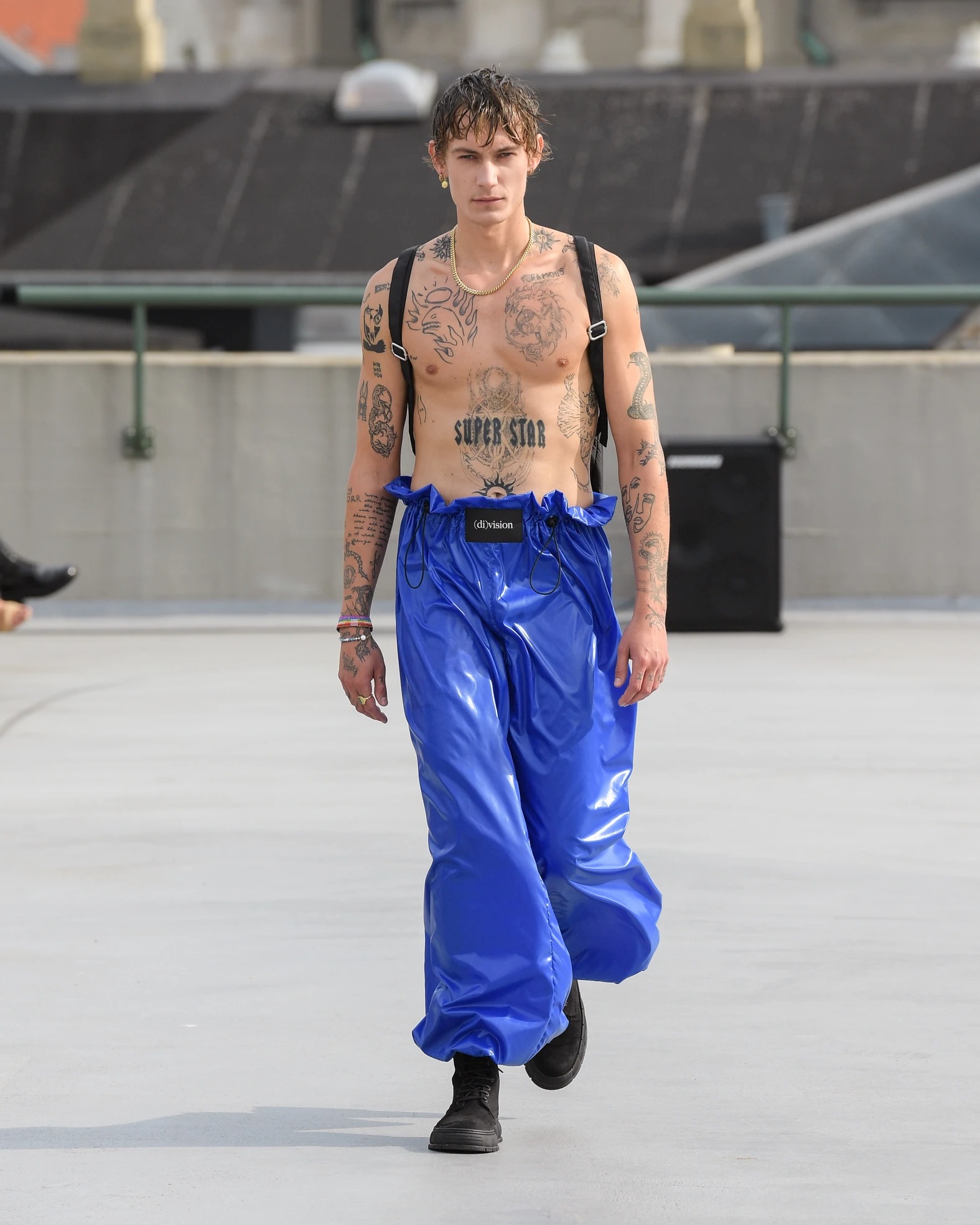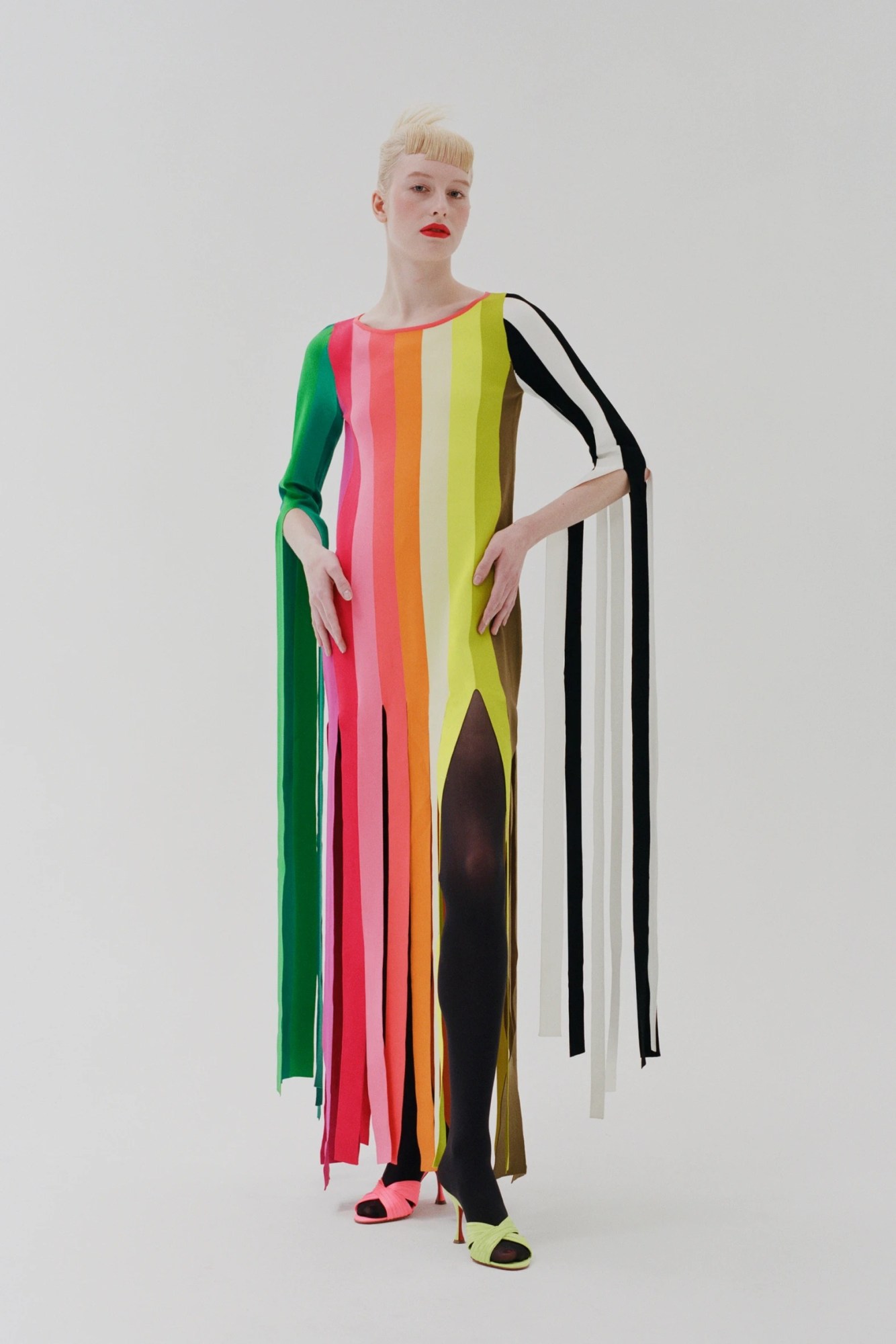If fashion TikTok is anything to go by, this is a clown’s world, and we’re all just living in it. With close to 210 million views on the platform, #clowncore has accrued a vast cohort of enthusiasts and fashion content creators, each putting their spin on the larger-than-life aesthetic. Defined by bold primary colors, garishly mixed patterns and prints, and emphasized textures, it’s hardly a look for the timid – and yet, its hallmarks are increasingly making themselves felt beyond the genre’s URL home, spilling over onto high-end ready-to-wear runways. It’s a move that makes sense at a time when the virtues of personal style and shameless self-performance are being so loudly trumpeted in both fashion and wider pop culture, but its rise begs the question: where does the line between being one’s true self and just clowning about lie?
Granted, it should be noted that most people who dress in clowncore typically don’t see themselves as donning costumes, but rather as dressing in a way that allows them to fully step into and inhabit their identities. “Clowncore is a way I express myself as well as an art form,” shares Cloud Ross, a clowncore enthusiast.
“If I weren’t able to dress in clown core, I wouldn’t be myself,” they continue, noting the sense of community that engaging with like-minded fashion fans online has given them: “It’s given me many opportunities to connect with others who dress in clowncore, with some of them even doing trades with me for jewellery and Kandi,” they say, referring to the pony bead bracelets that are typically traded in rave and scene cultures.
That clowncore is theatrical in nature is a given, but it’s exactly these escapist qualities that are driving its current swell in popularity. It speaks to a general desire for escape, Kelley Heyer, a fashion content creator, says — “a desire to be silly and opulent and witty as things grow dark around us. We need to find joy somewhere and I think putting on these clothes, this costume of a clown, gives us permission to be a character and express our own joy,” she continues, with her own #clowncore channelling all a manner of clown archetypes: the pierrot, the harlequin, and the circus clown among them.
While clowncore may certainly be thriving online, its signatures can be seen on runways, too. Paloma Wool’s harlequin diamond-checked sweaters exude clownishness through mismatched prints that utilise optical illusions in vibrant colours, while Charles Jeffrey Loverboy’s intermingling of tartan patterns, rainbow stripes and paint splatters echo the joyful eccentricity of many of the looks you’ll see online.

Shown during Copenhagen Fashion Week SS22, (di)vision’s debut collection featured off-kilter colour contrasts and billowing blue pants parachute pants that implicitly nodded to the sort that you’d subdued hints from those you might see your birthday-party variety clown in. Granted, that wasn’t necessarily what the designers had in mind. “To be honest we hadn’t heard about clown-core before this,” say Nanna and Simon Wick, the brand’s sibling co-founders.
“We try to make clothes that make you stand out as an individual and furthermore we try to make everything we do as inclusive as possible. This often ends up in oversized silhouettes and a wide range of color blocks and color mixes. Just as the number one clown, ‘The Joker’, says: “Why so serious?”. And we’ve always followed that logic, trying not to take things too seriously. So maybe the clowncore parallel comes from a more free-spirited approach.”
Still, if you’re looking for direct high fashion parallels, there are plenty to draw out. Fashion content creator Estelle De La Fuente, for example, sees the emergence of clown core as a collateral effect of the ongoing y2k revival. “It’s reminiscent of Galliano-era Dior, and particularly his Fall 2003 ready-to-wear collection,” a spiritual precursor to clowncore, she says, for its playfully exaggerated textures and intense, fantastical makeup looks. More recently, designer Batsheva Hay embraced a clownish energy with her namesake label’s Pre-Fall 2022 collection, replete with huge billowing dresses decorated with pom-poms and ruffles. “The clownishness of the collection comes from a desire to have fun, to not be so serious, that comes from us all living through a very sad and difficult time. The world is so scary and grim right now that serious and repressed clothing seems too much,” the designer shares. “We may as well have fun in the small ways that we can, and I think pushing the boundaries of what is costumey or clownish is a part of that exploration for me. Also, being more detached from the world these past two years has let me play around more, like a child in their closet, and made me explore the idea of a character like a clown.”
Elsewhere, Christopher John Rogers’ latest offering embrace the ethos of clowncore more subtly, using graphic lively stripes, polka dots to create sense of pinwheel fantasy. “Ever since I’ve started designing, I’ve always been inspired by the archetype of the pierrot and associated clown-like aesthetics (large jumpsuits, ruffles, graphic stripes and checks, etc.),” says Christopher. “It’s therefore something that’s always in the back of my mind every season,” with the bold prints and hues and dramatic volumes that characterise his work forming the bedrock of his brand’s aesthetic.

So there you have it. Clowns are everywhere now – well, except the circus it would seem. To some, it may seem silly that these intentionally cartoonish caricatures have become the source material for a fully-fledged fashion moment – an example of the trend cycle at its most inane. For many, though, donning brash primary colours and clashing textures isn’t about self-characterisation or performance for the sake of it. For them, clowncore ultimately boils down to an act of self-affirmation — of advocating for your loudest, boldest self with pride. If you make a clown of yourself while you’re at, then that’s all for the better.
Follow i-D on Instagram and TikTok for more fashion trend stories.
